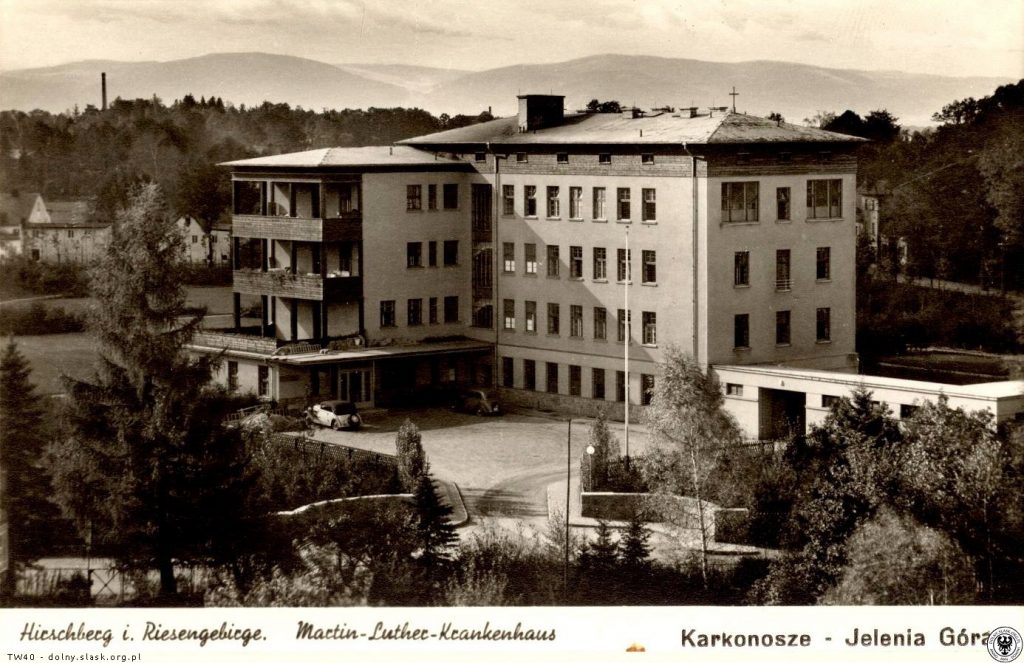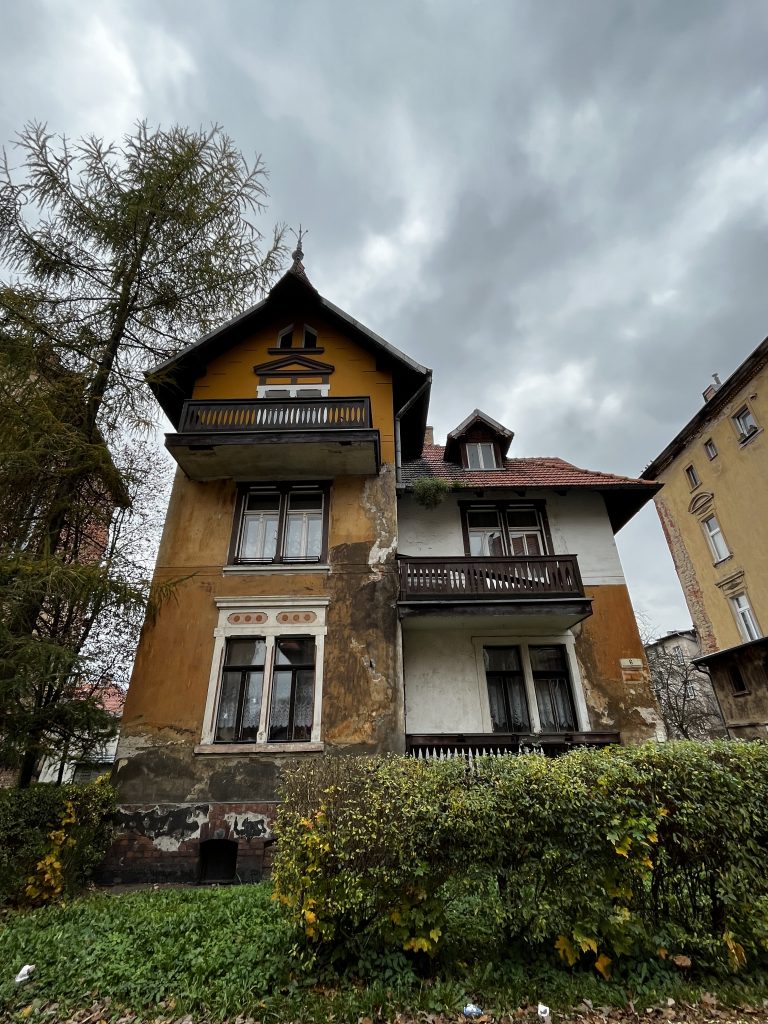Today is the anniversary of Rosel Aptekmann’s death, so her story will be the first in a series dedicated to people buried in the Jewish cemetery in Jelenia Góra (Hirschberg). Only a few tombstones with readable inscriptions have survived, just seven in total. Let’s learn about Rosel Aptekmann.

The gravestone of Rosel Aptekmann at the Jewish cemetery in Jelenia Góra / Photo: Marta Maćkowiak
On November 23, 1938, Leo Aptekmann came to the Civil Registry Office to report the death of his wife. Rosalie passed away on the same day at the age of 46 in the Martin Luther Evangelical Hospital in Jelenia Góra (formerly Hirschberg-Cunnersdorf). Presently, the building houses a Caritas care and medical facility (located at ul. Żeromskiego 2).
Two weeks after Kristallnacht. Perhaps this event had an impact on her health.

Rosalie Aptekmann’s death certificate / Source: Landesarchiv Berlin

Former Martin Luther Evangelical Hospital in Jelenia Góra, now Caritas care and medical facility at ul. Żeromskiego 2 / Source: Polska-org.pl
Leo and Rosalie lived at Hermann Göringstrasse 43 (formerly, before 1933, Warmbrunnerstrasse, now ul. Wolności), 600 meters from the hospital. According to available sources, it seems that the numbering of buildings has not changed.

The building on ul. Wolności (formerly Warmbrunnerstrasse/Hermann Göringstrasse) in Jelenia Góra / Source: Polska-org.pl

The building at ul. 43 Wolności 43 in Jelenia Góra today / Photo by Marta Maćkowiak.
The Aptekmanns were married for just under two decades, having tied the knot in Jelenia Góra on August 12, 1919.
Leo Aptekmann arrived in Jelenia Góra from Ukraine, specifically from the city of Smila, where he was born on February 25, 1892, as the son of Israel Aptekmann, a merchant, and Sophie née Brodski, residents of Kiev.
Rosalie, née Hirschstein, came into the world in Jelenia Góra on December 19, 1891, as the daughter of Julius Adolph Hirschstein, a merchant, and Rosalie née Moritz, who lived in Jelenia Góra in a house at plac Ratuszowy 4.
Leo and Rosalie initially resided at today’s ul. Wolności 32, in a house adorned with David’s stars on the veranda. Today, in addition to apartments, there is a shop and a Pentecostal church at that location.





Building at ul. Wolności 32 in Jelenia Góra / Photo: Marta Maćkowiak

Tenement at plac Ratuszowy 4 in Jelenia Góra, fragment from the exhibition at the Karkonosze Museum / Source: polska-org.pl

Marriage certificate of Julius Hirschstein and Rosalie Moritz in Mainz / Source: Mainz City Archive
It is unknown whether Leo and Rosalie Aptekmann had any descendants. So far, I haven’t come across any trace of them, and it is also unclear whether Leo remarried.
However, it is certain that after Rosalie’s death, her husband lived for some time at Jägerstrasse 6 (today ul. Wyczółkowskiego) until he was deported and killed at Majdanek concentration camp.

Building at ul.Wyczółkowskiego 6 in Jelenia Góra / Photo: Marta Maćkowiak
Sources:
Końcowy raport składa się z kopi odnalezionych dokumentów, tłumaczeń, zdjęć oraz podsumowania. Wyjaśniam pokrewieństwo odnalezionych osób, opisuję sprawdzone źródła i kontekst historyczny. Najczęściej poszukiwania dzielone są na parę etapów i opisuję możliwości kontynuacji.
Czasem konkretny dokument może zostać nie odnaleziony z różnych przyczyn – migracji do innych wiosek/miast w dalszych pokoleniach, ochrzczenia w innej parafii, lukach w księgach, zniszczeń dokumentów w pożarach lub w czasie wojen. Cena końcowa w takiej sytuacji nie ulega zmienia, ponieważ wysiłek włożony w poszukiwania jest taki sam bez względu na rezultat.
Raporty mogą się od siebie mniej lub bardziej różnić w zależności od miejsca, z którego rodzina pochodziła (np. dokumenty z zaboru pruskiego, austriackiego i rosyjskiego różnią się od siebie formą i treścią).
Na podstawie zebranych informacji (Twoich i moich) przygotuję plan i wycenę – jeśli ją zaakceptujesz, po otrzymaniu zaliczki rozpoczynam pracę i informuję o przewidywanym czasie ukończenia usługi. Standardowe poszukiwania trwają około 1 miesiąca, a o wszelkich zmianach będę informować Cię na bieżąco.
Na Twoje zapytanie odpiszę w ciągu 3 dni roboczych i jest to etap bezpłatny. Być może zadam parę dodatkowych pytań, dopytam o cele albo od razu przedstawię propozycję kolejnych kroków.
Warto pamiętać, że im więcej szczegółów podasz, tym więcej rzeczy mogę odkryć.
Podziel się ze mną:
I najważniejsze – jeśli masz niewiele informacji, zupełnie się tym nie martw, w takich sytuacjach także znajdę rozwiązanie.